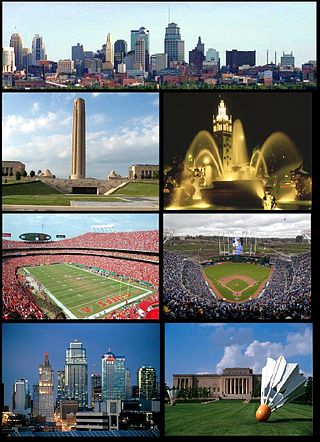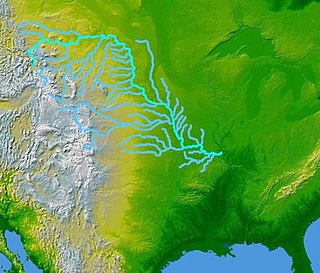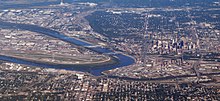
Kansas City, Missouri is the largest city in the U.S. state of Missouri by population and area. Most of the city lies within Jackson County, with portions spilling into Clay, Platte, and Cass counties. It is the urban central city of the Kansas City metropolitan area, which straddles the Missouri–Kansas state line and has a population of 2,392,035. As of the 2020 census, the city had a population of 508,090, making it the 37th most-populous city in the United States, as well as the sixth-most populous city in the Midwest. Kansas City was founded in the 1830s as a port on the Missouri River at its confluence with the Kansas River from the west. On June 1, 1850, the town of Kansas was incorporated; shortly after came the establishment of the Kansas Territory. Confusion between the two ensued, and the name Kansas City was assigned to distinguish them soon after.

Jackson County is located in the western portion of the U.S. state of Missouri, on the border with Kansas. As of the 2020 census, the population was 717,204. making it the second-most populous county in the state.

Thomas Joseph Pendergast, also known as T. J. Pendergast, was an American political boss who controlled Kansas City and Jackson County, Missouri, from 1925 to 1939.

The Kansas City metropolitan area is a bi-state metropolitan area around Kansas City, Missouri. Its 14 counties straddle the border between the U.S. states of Missouri and Kansas, covering 8,472 square miles (21,940 km2) and having a population of more than 2.2 million people. It is the second-largest metropolitan area that had a dominant historic core city in Missouri in the 1950s and is the largest metropolitan area in Kansas, though Wichita is the largest metropolitan area that has its 1950s dominant historic core city in Kansas. Alongside Kansas City, Missouri, these are the suburbs with populations above 100,000: Overland Park, Kansas; Kansas City, Kansas; Olathe, Kansas; Independence, Missouri; and Lee's Summit, Missouri.

Hy-Vee Arena, previously known as Kemper Arena, is an indoor arena located in Kansas City, Missouri. Prior to conversion to a youth sports and community gymnasium facility, Kemper Arena was previously a 19,500-seat professional sports arena. It has hosted NCAA Final Four basketball games, professional basketball and hockey teams, professional wrestling events, the 1976 Republican National Convention, concerts, and is the ongoing host of the American Royal livestock show.

Municipal Auditorium is a multi-purpose facility located in Kansas City, Missouri. It opened in 1935 and features Streamline Moderne and Art Deco architecture and architectural details.

In mid-July 1951, heavy rains led to a great rise of water in the Kansas River, Missouri River, and other surrounding areas of the Central United States. Flooding occurred in the Kansas, Neosho, Marais Des Cygnes, and Verdigris river basins. The damage in June and July 1951 across eastern Kansas and Missouri exceeded $935 million. The flooding killed 17 people and displaced 518,000.

Quality Hill is a historic neighborhood near downtown Kansas City, Missouri, USA, on a 200-foot-high bluff which overlooks the confluence of the Kansas and Missouri rivers in the West Bottoms below.
Strawberry Hill is a historic neighborhood in Kansas City, Kansas, United States. It is bordered by Minnesota Avenue to its north, by Interstate 70 to its east and south, and by 7th Street to its west.

The history of the Kansas City metropolitan area has significant records since the 19th century, when Frenchmen from St. Louis, Missouri moved up the Missouri River to trap for furs and trade with the Native Americans. This strategic point for commerce and security at the confluence of the Kansas and Missouri Rivers became the Kansas City metropolitan area, straddling the border between Missouri and Kansas. Kansas City, Missouri was founded in 1838 and surpassed the competing Westport to become the predominant city west of St. Louis. The area had a major role in the westward expansion of the United States. The Santa Fe and Oregon trails ran through the area. In 1854, when Kansas was opened to Euro-American settlement, the Missouri-Kansas border became the first battlefield in the conflict in the American Civil War.

Harry Darby was an American politician from Kansas.
The Kansas City Stockyards in the West Bottoms west of downtown Kansas City, Missouri flourished from 1871 until closing in 1991. Jay B. Dillingham was the President of the stockyards from 1948 to its closing in 1991.
Jay B. Dillingham was a former president of the Kansas City Stockyards as well as former president of the Chamber of Commerce for both Kansas City, Missouri and Kansas City, Kansas.

The Library District is an officially designated neighborhood in Downtown Kansas City, Missouri, United States, roughly bounded by 9th and 11th Streets on the north and south and Main Street and Broadway on the east and west. The District contains a sub-district named the West Ninth Street/Baltimore Avenue Historic District listed on the National Register and which includes several buildings individually listed on the National Register of Historic Places. It also contains other notable structures not listed on the National Register.

William Thornton Kemper Sr. was an American banker who was the patriarch of the Missouri Kemper family, which developed both Commerce Bancshares and United Missouri Bank to become a major banking family in the Midwest.
The Rock Island Bridge in Kansas City, Kansas is a rail crossing of the Kansas River. It connects the Armourdale, Kansas to West Bottoms. It is a truss bridge that is closed to traffic.

The Missouri River Valley outlines the journey of the Missouri River from its headwaters where the Madison, Jefferson and Gallatin Rivers flow together in Montana to its confluence with the Mississippi River in the State of Missouri. At 2,300 miles (3,700 km) long the valley drains one-sixth of the United States, and is the longest river valley on the North American continent. The valley in the Missouri River basin includes river bottoms and floodplains.

The Kansas City Club, founded in 1882 and located in the Library District of Downtown Kansas City, Missouri, USA, was the oldest gentlemen's club in Missouri. The club began admitting women members in 1975. Along with the River Club on nearby Quality Hill, it was one of two surviving private city clubs on the Missouri side of Kansas City. Notable members include Presidents Harry Truman and Dwight D. Eisenhower, General Omar Bradley, and political boss Tom Pendergast. It closed in 2015.

The Golden Ox is a steakhouse restaurant located in the Kansas City Live Stock Exchange building in the West Bottoms neighborhood of Kansas City, Missouri. Founded in 1949, the Golden Ox is the birthplace of the Kansas City strip steak. The Golden Ox is considered the oldest steakhouse in Kansas City, because though Jess & Jim's Steakhouse had opened more than one decade earlier in 1938, its Martin City neighborhood was not annexed into Kansas City until 1963. The original Golden Ox location closed permanently following dinner on December 20, 2014. On June 8, 2018, new owners leased the space and reopened the Golden Ox in a renovated portion of the original space.
Polish Hill is a neighborhood in Kansas City, Kansas, located southwest of Strawberry Hill, that was historically occupied by mixed Slavic and Eastern European immigrants.
















